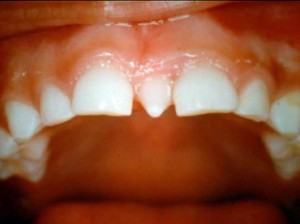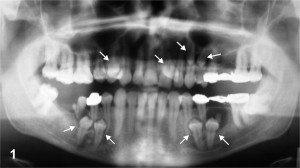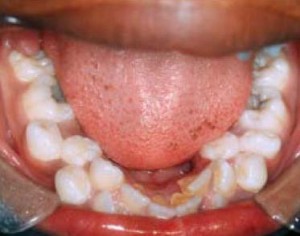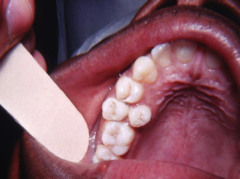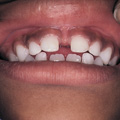Did you ever wonder why do you find some children with a small extra tooth in between their permanent incisors?
This small little tooth is called Supernumerary Tooth.
Â
A Supernumerary Tooth is one that is additional to the normal series and can be found in almost any region of the dental arch. Most supernumerary teeth are located in the upper incisors region commonly known as mesiodens. Their presence may give rise to a variety of clinical problems in the future for children.
Â
Prevalence
Â
Supernumerary teeth can occur as singles, multiples, unilaterally or bilaterally, erupted or impacted, and in one or both jaws. Having multiple supernumerary teeth are rare in individuals with no other associated diseases or syndromes. However, the conditions commonly associated with multiple supernumeraries are cleft lip and palate, cleidocranial dysplasia and Gardner syndrome.
Â
Â
It is reported that the prevalence ranges between 0.3-0.8 per cent in the primary dentition with no significant sex distribution. While 0.1-3.8 per cent in the permanent dentition with males affected approximately twice as frequently as females in the permanent dentition.
Â
The Cause
Â
It is not completely understood on what causes supernumeraries to form. However, the well supported literature states that it is the hyperactivity theory of the dental tissues (i.e. dental lamina). Genetic factors may be considered important in the occurrence of this anomaly as many cases reported of recurrence within the same family. A sex-linked inheritance has been suggested by the observation on why males are affected twice as much.
Â
Classification and Clinical Features
Â
Supernumerary teeth are classified based on their morphology and location.
Â
Classification based on Morphology
Â
| Types of Supernumerary | Relative Occurrence | Common Locations | Typical Clinical Appearance |
| Conical | 75% | Upper central incisors | Small structures with triangular or conical crown |
| Tuberculate | 12% | Upper central incisors | Barrel-shaped crown with multiple tubercles |
| Supplemental | 7% | Any location (most common permanent upper lateral incisor) | Appearance of a normal tooth |
| Odontome | 6% | Upper incisors and lower molars | Numerous small tooth-like structures or a single, irregular mass |
© Dental Update 2008; 35:510-520
Â
Â
Classification based on location
Â
| Types of Supernumerary | Common Locations | Typical Clinical Appearance |
| Mesiodens | Between maxillary central incisors | Conical |
| Paramolar | Adjacent to one of the molars | Supplemental |
| Distomolar | Located distally to a third molar | Supplemental |
| Parapremolar | Premolar region | Supplemental |
© Dental Update 2008; 35:510-520
Â
Complications
Â
A supernumerary tooth can be discovered by chance of a routine radiograph which does not impose any complications. However, if complication arises, they may include the following:
Â
1. Failure or delayed eruption of associated permanent teeth
2. Crowding or displacement of permanent teeth
3. Pathology with the supernumerary itself (cystic formation for example; dentigerous cyst or odontoma)
4. Abnormal or delayed root development of associated permanent teeth
5. Incomplete space closure during orthodontic treatment
6. Root resorption of adjacent teeth
7. Late-forming supernumerary teeth (There is a 24 percent possibility for patients with history of supernumerary at an early age to develop supernumerary in the future at another region in the dentition)
Â
Â
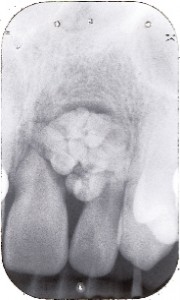
An irregular mass (odontome) seen in this radiograph involving root resorption of permanent teeth. ©JCDA
Â
Â
Diagnosis
Â
Parents should be aware of the possible presence of supernumerary teeth if you notice one of the following in your child:
Â
1. Persistently retained primary incisor
2. Failure of eruption of a permanent tooth
3. A wide diastema
4. Rotation of erupted permanent incisors
Â
Appropriate radiographic investigations should be carried out by clinicians to rule out any incidence of supernumeraries.
Â
Management of Supernumerary teeth
To remove or not to remove?
Â
The management should form part of a comprehensive treatment plan and should not be considered in isolation. Â It should be carefully weighing between the benefits and the risks of removing or not to remove the supernumeraries.
Â
Treatment depends on the type and position of the supernumerary tooth, its potential effect on the adjacent teeth and may or may not involving surgery. In the final stage of treatment, the child will usually need orthodontic treatment either fixed or removable appliance for realignment of dentition. It is best to detect this anomaly as early as possible for the child as to intercept future complication arises.
Â
Parents play an important role in participating in the treatment planning as it will be progressively carried out throughout the years of the child’s growth. Treatment can be difficult based on individual cases and it can be stressful to the child therefore parents should be supportive at every step of the treatment.
Â
Â
Â
Â
